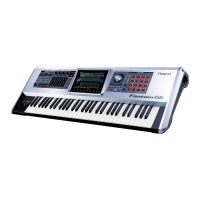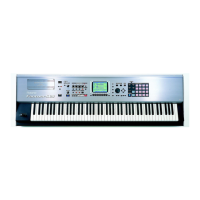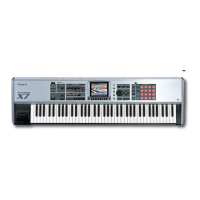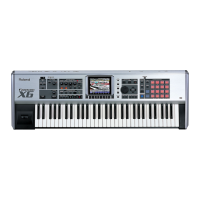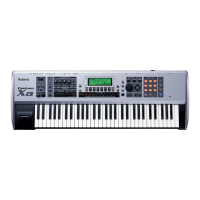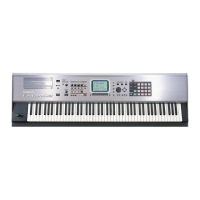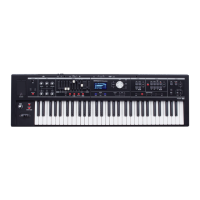129
Creating a Sample Set
Overview Sound 1 Sound 2 Sound 3 Pad Sampler
Menu/System
AppendixSequencer
This section explains the functions the different sample set
parameters have, as well as the composition of these parameters.
If a number is displayed for the parameter name, ( , , ,
), you can use the realtime controller knob of the corresponding
number (the left most knob is number 1, the right most knob is
number 4) to set the value.
fig.06-010
Sample Set Level, Sample Set MFX Switch, Sample Set Chorus
Switch and Sample Set Reverb Switch applies to the entire
sample set; the other parameters are set individually for each
sample set tone.
Sample Set Name
Specifies the name of the sample set.
By pressing [ENTER], you can assign a name to the sample set.
Value:
space, A–Z, a–z, 0–9, ! ” # $ % & ’ ( ) * + , - . / : ; < = > ? @ [ \ ] ^ _ ` { | }
For details on entering a name, refer to
“Assigning a Name”
(p. 42).
Sample Set Level
Sets the volume of the sample set.
Value:
0–127
The volume levels of the tones from which the sample set is
composed is set with the Tone Level parameter (p. 131).
Direction
Specifies the direction in which the sample will play.
Value:
FWD:
Play forward.
REV:
Play backward.
Trigger Mode
Specifies how the sample will play when you press a pad (or key).
Value:
GATE:
The sample will stop playing when you release the pad
(or key).
DRUM:
The sample will continue playing even after you release
the pad (or key).
The sample will begin playing when you press the pad, and will
stop automatically when the end of the sample is reached. If
you select the DRUM setting, the Loop setting is ignored; the
sample will play only once. Note that if you select DRUM, you
will not be able to interrupt the sound, so use this setting with
caution if the sample is extremely long.
Mute Group
On an actual acoustic drum set, an open hi-hat and a closed hi-hat
sound can never occur simultaneously. To reproduce the reality of
this situation, you can set up a Mute Group.
The Mute Group function allows you to designate two or more
sample tones that are not allowed to sound simultaneously. Up to 16
Mute Groups can be used. sample tones that are not belong to any
such group should be set to “OFF.”
Value:
OFF, 1–16
Functions of Sample Set
Parameters
Making Settings Common to the
Entire Sample Set (General)
Fantom-G_r_e.book 129 ページ 2009年7月2日 木曜日 午後2時55分

